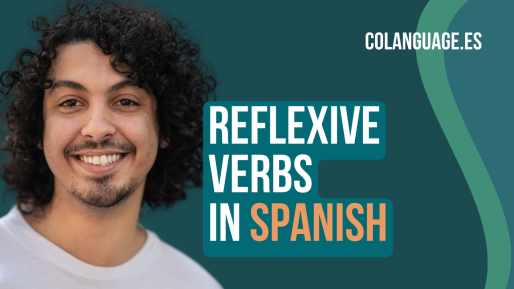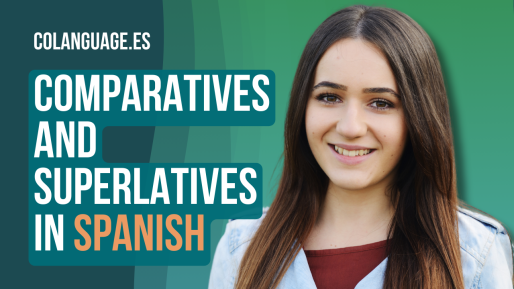Demonstrative adjectives in Spanish (this, that, these, those) Share Copied!
Spanish
Discover Spanish demonstrative adjectives: this, that, these, those - essential for precision and clarity in communication.
Video
Podcast
What are demonstrative adjectives?
Demonstrative adjectives are used to indicate the proximity of a noun in relation to the speaker.
-
Me gusta esta camisa porque es cómoda. (I like this shirt because it's comfortable.)close to speaker
-
Ese cuadro de la esquina es hermoso. (That painting on the corner is beautiful.)medium distance
-
Aquellas montañas a lo lejos tienen nieve. (Those mountains in the distance have snow.)far from the speaker
In Spanish, there are three types of demonstrative adjectives, depending on the distance of the noun being described, where as in English, we only have two levels of proximity: "this" and "that".
This and these: "este", "esta", "estos", "estas" in Spanish
This set of demonstrative adjectives is used to describe objects that are close to the speaker.
| Number and gender | Spanish | English |
|---|---|---|
| Singular, masculine | Este fin de semana me gustaría ir a la montaña. | This weekend I would like to go to the mountains. |
| Singular, feminine | Esta mañana me levanté de buen humor. | This morning I woke up in a good mood. |
| Plural, masculine | Estos libros son de mi autor favorito. | These books are from my favorite author. |
| Plural, feminine | Estas son las flores que me gustan. | These are the flowers I like. |
The distance can be time-related or physical distance from the object.
Esta mañana (This morning)time distance
Estos libros (These books)physical distance
Listening exercise
This dialogue shows how the demonstrative adjectives "este", "esta", "estos" and "estas" can be used.
| Spanish | English | |
|---|---|---|
| María | ¿Qué te parece este restaurante? | What do you think of this restaurant? |
| Daniel | Es elegante, pero creo que estos precios son un poco altos. | It's elegant, but I think these prices are a bit high. |
| María | Es verdad, pero estas vistas al mar son insuperables. | It's true, but these ocean views are unbeatable. |
| Daniel | Totalmente de acuerdo. Esta noche dormiremos muy bien. | Totally agree. We'll sleep very well tonight. |
That and those: "ese", "esa", "esos", "esas" in Spanish
"Ese", "esa", "esos" and "esas" are demonstrative adjectives in Spanish used to indicate objects or people that are near the listener but farther from the speaker.
| Number and gender | Spanish | English |
|---|---|---|
| Singular, masculine | Aún me acuerdo de ese año. | I still remember that year. |
| Singular, feminine | Esa canción siempre me levanta el ánimo. | That song always cheers me up. |
| Plural, masculine | ¿Qué te parecen esos asientos? | What do you think of those seats over there? |
| Plural, feminine | ¿Esas llaves son tuyas? | Are those keys over there yours? |
Demonstrative adjectives agree in gender and number with the noun they modify.
Año (Year) is singular and masculine, so we use "ese"
Llaves (Keys) is plural and feminine, so we use "esas"
Listening exercise
In this table you can see the use of the demonstrative adjectives "ese", "esa", "esos" and "esas" in Spanish.
| Spanish | English | |
|---|---|---|
| María | ¿Recuerdas esa fiesta en mi casa el año pasado? | Do you remember that party at my house last year? |
| Daniel | Sí, ese día fue increíble. | Yes, that day was amazing. |
| María | ¿Vas a ir a la fiesta de cumpleaños mañana? | Are you going to the birthday party tomorrow? |
| Daniel | Sí. Además, viene esa banda local que toca muy bien. | Yes. Also, that local band that plays very well is coming. |
| María | ¡Genial! Esos músicos tienen mucho talento. | Great! Those musicians are very talented. |
That and those (over there): "aquel", "aquella", "aquellos", "aquellas" in Spanish
In English, we use "that" and "those" to refer to something that is not close to us.
| Number and gender | Spanish | English |
|---|---|---|
| Singular, masculine | Aquel libro que leí de niño me marcó profundamente. | That book I read as a child had a profound impact on me. |
| Singular, feminine | Aquella experiencia me cambió. | That experience changed me. |
| Plural, masculine | Aún recuerdo aquellos días de verano. | I still remember those summer days. |
| Plural, feminine | Yo solía subir hasta aquellas colinas. | I used to climb up those hills over there. |
Unlike English, in Spanish there is another layer of proximity. To be more accurate, in English we could use "that over there" and "those over there".
Listening exercise
In this listening exercise you can practise the demonstrative adjectives "aquel", "aquella", "aquellos", "aquellas".
| Spanish | English | |
|---|---|---|
| María | ¿Cómo se llaman estas flores? | What are these flowers called? |
| Daniel | Estas flores son rosas. | These flowers are roses. |
| María | ¿Y esos árboles de ahí? | And those trees over there? |
| Daniel | Esos árboles se llaman robles. | Those trees are called oak trees. |
| María | ¿Y aquellas montañas de allí? | And those mountains over there? |
| Daniel | Aquellas son las montañas Rocosas. | Those over there are the Rocky Mountains. |
Key takeaways
Here is a quick summary of this lesson.
- There are three types of demonstrative adjectives depending on the level of proximity.
- The distance can be time-related or physical distance from the object.
- They agree in gender and number with the noun they modify.
Subscribe to our social media channels to get free daily exercises!



